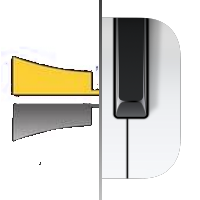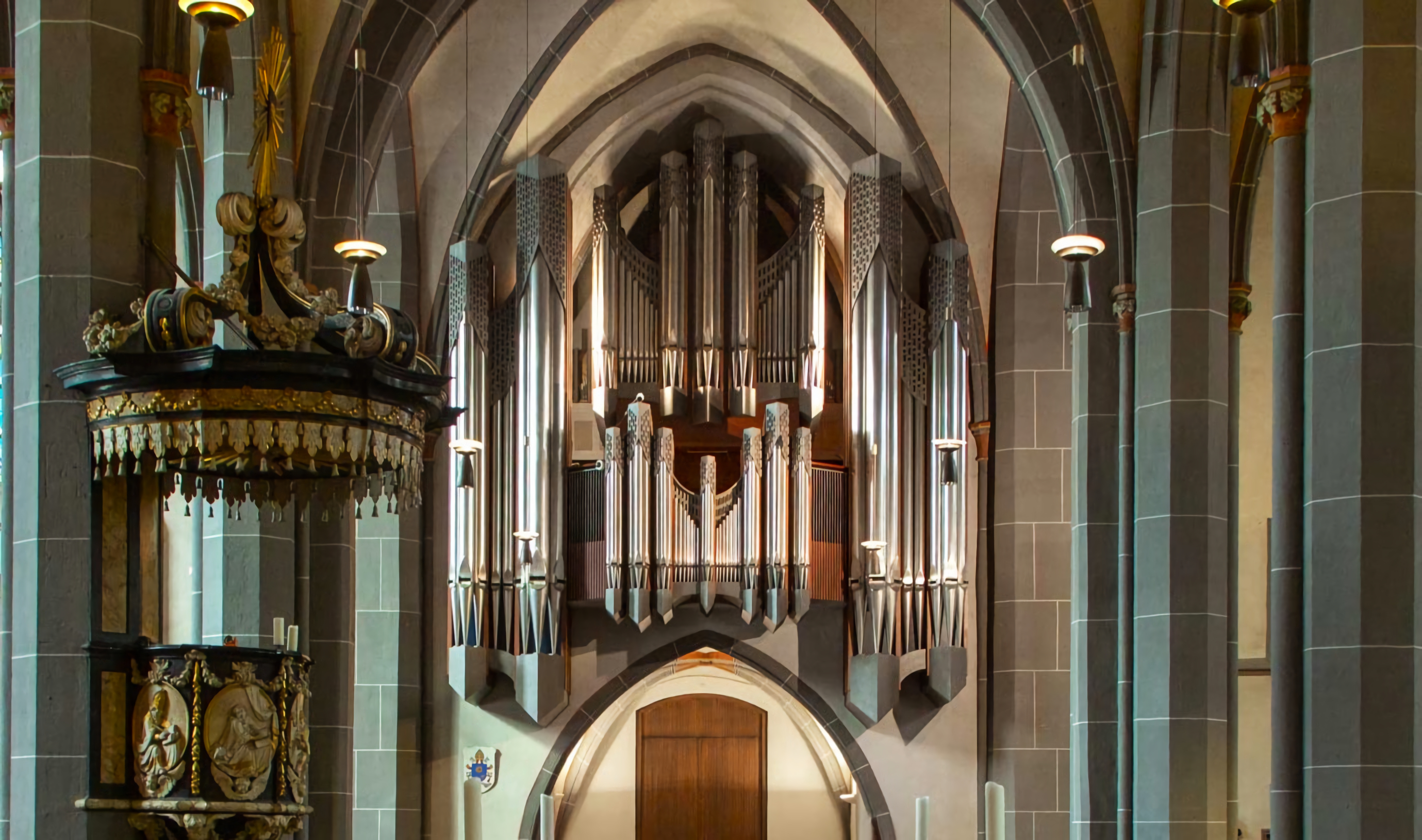Düsseldorf, Basilika St. Lambertus (Hauptorgel/Main Organ)
| Builder | Rieger |
|---|---|
| Year | ca. 1999 |
| Period/Style | Symphonic |
| Stops | 54 |
| Keyboards | 4+P |
| Keyaction | electrical |
| Tuning | Equal at 440 Hz |
| Sampleset |
Available
 , sampled by
Piotr Grabowski
, sampled by
Piotr Grabowski
|
The basilica of St. Lambertus is located in the very center of Düsseldorf’s historic old town. Over the years various organs have been installed in the church. The current instrument was built by Rieger (Austria). The main organ (Hauptorgel), with 54 voices, was built in 1999. It has 4 divisions (Grand Orgue, Positif, Récit, Pédale) assigned to 3 manuals and pedal, operated by tracker action. 5 years later, in 2004, a choir organ (Chororgel) was built, located on the right side of the altar.
In the main organ, the pedal towers (on both sides) contain the largest pipes of the GO Montre 16′ and other pedal flue stops. The largest Soubasse 32′ voice pipes are located at the back of the organ case. The Positif division is located behind the organist’s back, suspended from the choir balustrade. In the middle of the façade in the front, the Grand Orgue is located. Behind it sit pedal reed stops and behind them the Récit division is enclosed in a swell box.
Both instruments can be operated thanks to a mobile console equipped with 4 manuals and pedal. Pedal keyboard supports operation of the Pédale division of both organs.
1st manual operates the Grand Orgue of the main organ and (unless the ChO Grand Orgue IV Man coupler is engaged) Grand Orgue of the choir organ.
2nd manual operates Positif of the main organ and (unless the ChO Récit IV Man connection is enabled) Récit of the choir organ.
3rd manual operates Récit of the main organ.
4rd manual by default isn’t connected to any division. It can be connected to choir organ divisions with ChO IV Man couplers.
The organ is equipped with a switch enabling quick switching between instruments whose stops should play. By default, in the “Both organs” mode, all of the stops are active. In the “Single organ” mode, the main/choir organ selection mode is activated. This allows you to quickly switch between playing both organs and the choir organ, or between two organs – creating an easy way to dialogue.
The organs of St. Lambertus are of some particular interest. On the one hand they are built as typical Rieger instruments, with the well-known and highly acclaimed bright and brilliant sound of this famous workshop – light Principals and Mixtures are ideal for very convincing performances of baroque organ music, including Bach. On the other hand, the shape of the specification is designed completely in French symphonic style, with typical reeds, Montres, Flûtes and string stops. These organs seem to be quite different from other instruments by Rieger.
Also the design of the main organ and choir organ is in itself unusual – they are not two different instruments in different styles. The choir organ was designed as a completely standalone instrument, very similar in sound structure to its “big sister”. The organist has the fine chance to enrich the sound of the main instrument in the fine acoustics of St. Lambertus and to overwhelm the audience in the middle of the church with this “prolongement”.
In the main organ, the pedal towers (on both sides) contain the largest pipes of the GO Montre 16′ and other pedal flue stops. The largest Soubasse 32′ voice pipes are located at the back of the organ case. The Positif division is located behind the organist’s back, suspended from the choir balustrade. In the middle of the façade in the front, the Grand Orgue is located. Behind it sit pedal reed stops and behind them the Récit division is enclosed in a swell box.
Both instruments can be operated thanks to a mobile console equipped with 4 manuals and pedal. Pedal keyboard supports operation of the Pédale division of both organs.
1st manual operates the Grand Orgue of the main organ and (unless the ChO Grand Orgue IV Man coupler is engaged) Grand Orgue of the choir organ.
2nd manual operates Positif of the main organ and (unless the ChO Récit IV Man connection is enabled) Récit of the choir organ.
3rd manual operates Récit of the main organ.
4rd manual by default isn’t connected to any division. It can be connected to choir organ divisions with ChO IV Man couplers.
The organ is equipped with a switch enabling quick switching between instruments whose stops should play. By default, in the “Both organs” mode, all of the stops are active. In the “Single organ” mode, the main/choir organ selection mode is activated. This allows you to quickly switch between playing both organs and the choir organ, or between two organs – creating an easy way to dialogue.
The organs of St. Lambertus are of some particular interest. On the one hand they are built as typical Rieger instruments, with the well-known and highly acclaimed bright and brilliant sound of this famous workshop – light Principals and Mixtures are ideal for very convincing performances of baroque organ music, including Bach. On the other hand, the shape of the specification is designed completely in French symphonic style, with typical reeds, Montres, Flûtes and string stops. These organs seem to be quite different from other instruments by Rieger.
Also the design of the main organ and choir organ is in itself unusual – they are not two different instruments in different styles. The choir organ was designed as a completely standalone instrument, very similar in sound structure to its “big sister”. The organist has the fine chance to enrich the sound of the main instrument in the fine acoustics of St. Lambertus and to overwhelm the audience in the middle of the church with this “prolongement”.
| Grand Orgue | Positif | Récit | IV MANUAL | Pédale |
|---|---|---|---|---|
| Montre 16′ | Montre 8′ | Bourdon 16′ | Soubasse 32′ | |
| Bourdon 16′ | Bourdon 8′ | Bourdon 8′ | Montre 16′ | |
| Montre 8′ | Salicional 8′ | Flûte creuse 8′ | Soubasse 16′ | |
| Bourdon 8′ | Prestant 4′ | Gambe 8′ | Principal 8′ | |
| Flûte harmonique 8′ | Flûte à cheminée 4′ | Voix céleste 8′ | Bourdon 8′ | |
| Gambe 8′ | Sesquialtera II 2 2/3′ | Prestant 4′ | Flûte 4′ | |
| Prestant 4′ | Flûte 2′ | Flûte octaviante 4′ | Contrebombarde 32′ | |
| Flûte 4′ | Larigot 1 1/3′ | Nazard 2 2/3′ | Bombarde 16′ | |
| Doublette 2′ | Fourniture IV 1′ | Octavin 2′ | Basson 16′ | |
| Fourniture IV 2 2/3′ | Trompette 8′ | Tierce 1 3/5′ | Trompette 8′ | |
| Cymbale 1 1/3′ | Cromorne 8′ | Piccolo 1′ | Clairon 4′ | |
| Cornet V 8′ | Plein Jeu V 2′ | |||
| Bombarde 16′ | Basson 16′ | |||
| Trompette 8′ | Trompette 8′ | |||
| Clairon 4′ | Hautbois 8′ | |||
| Clairon 4′ | ||||
| Voix humaine 8′ |
https://piotrgrabowski.pl/dusseldorf-st-lambertus/
 Pipe Organ Map
Pipe Organ Map




